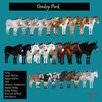-
Content Count
7672 -
Joined
-
Last visited
-
Days Won
222
Content Type
Forums
Blogs
Store
Calendar
Downloads
Gallery
Websites
Links Directory
Classifieds
Everything posted by SLGray
-
-
-
-
- 1 reply
-
- 1
-

-
-
- 1 reply
-
- 1
-

-
-
Name: Donkey Pack Creator: Slice XP needs: ES - for variants Language : english (but you will have english name and zoopedia even if you are using spanish, french, dutch or german client) Description: nine donkeys/wildass species with over 30 skins. Mesh is based on grant zebra model made by DutchDesign. Picture: zzzSlicesDonkeyPack.z2f
-
- 1 reply
-
- 1
-

-
-
-
Creator/Designer/Author: Laura 'Tamara' Henson & Kangorillophant. Language: English Bugs/Information/Notes: Seven deer species from South America. The Southern Pudu is the only animal with a bug, the baby turns white when you zoom out. Requirements: ZT2 & Endangered Species Picture: Red Brocket Peruvian Huemul Southern Huemul Marsh Deer Pampas Deer Northern Pudu Southern Pudu (Pudu pudu) American Deer Pack 2.z2f
- 1 reply
-
- 1
-

-
-
-
- 1 reply
-
- 1
-

-
-
-
-
- 1 reply
-
- 1
-

-
Author: Moondawg The Blesbok, or Blesbuck, (Damaliscus albifrons) is a subspecies of the Bontebok and it is purplish antelope with a distinctive white face and forehead. hey are close relatives of the Bontebok and are only found in South Africa (mostly in protected herds). They were first discovered in the 17th century, but it is not known whether this is because they are a relatively new species or because they have been so elusive. The Blesbok, or Blesbuck, (Damaliscus dorcas phillpsi) is related to the Bontebok (Damaliscus dorcas dorcas) and it is purplish antelope with a distinctive white face and forehead. Its white face is the origin of its name, because ‘bles’ is the Afrikaans word for blaze. Although they are close relatives of the Bontebok and they can interbreed creating an animal known as the Bontebles they do not share habitat, the Bontebok being found in large numbers on from as far south as Eastern Cape, the plains of the Free State and the Transvaal Highveld. They are a plains species and dislike wooded areas. The blesbuck is indigenous to South Africa and are found in large numbers in all national parks with open grasslands. They were first discovered in the 17th century, and were found in numbers so numerous that herds that reached from horizon to horizon where documented The neck and the top of the back of the blesbuck are brown. Lower down on the flanks and buttocks, the coloring becomes darker. The belly, the inside of the buttocks and the area up to the base of the tail are white. Blesbucks can be easily differentiated from other antelopes because they have a distinct white face and forehead. The legs are brown with a white patch behind the top part of the front legs. Lower legs whitish. Both sexes have horns, female horns are slightly more slender. The blesbok differs from the bontebok by having less white on the coat and the blaze on the face, which is usually divided, their coats are also a lighter brown than that of the bontebok. The length of their horns averages at around 38cm. Male adult blesboks average around 70kg, females average lower, at around 61kg. Blesboks can be found in open velds and open plains of South Africa. Preferred habitat is open grasslands with water. Blesbok by Moondawg.zip
-
-
-
-
Designer: Moondawg The horse belongs to an order known as the Perissodactyls, or "odd-toed ungulates", which all share hoofed feet and an odd number of toes on each foot. Horses appeared to be absent from the Americas until the Spanish Conquistadors brought domestic horses from Europe in the 16th Century, and escaped horses quickly established large wild herds. The early naturalist Buffon suggested in the 1760s that this was an indication of inferiority of fauna in the New World, then later reconsidered this idea. William Clark's 1807 expedition to Big Bone Lick found "leg and foot bones of the Horses" which were included with other fossils sent to Thomas Jefferson and evaluated by the anatomist Caspar Wistar, but neither commented on the significance of this find. During the Beagle survey expedition the young naturalist Charles Darwin had remarkable success with fossil hunting in Patagonia. On 10 October 1833 at Santa Fe, Argentina, he was "filled with astonishment" when he found a horse's tooth in the same stratum as fossil giant armadillos, and wondered if it might have been washed down from a later layer, but concluded that this was "not very probable". After the expedition returned in 1836 the anatomist Richard Owen confirmed that the tooth was from an extinct species which he subsequently named Equus curvidens, and remarked that "This evidence of the former existence of a genus, which, as regards South America, had become extinct, and has a second time been introduced into that Continent, is not one of the least interesting fruits of Mr. Darwin's palæontological discoveries." In 1848 a study On the fossil horses of America by Joseph Leidy systematically examined Pleistocene horse fossils from various collections including that of the Academy of Natural Sciences and concluded that there hadbeen at least two ancient horse species in North America, Equus curvidens and another which he named Equus americanus, but a decade later he found that name had already been taken and renamed it Equus complicatus. In the same year he visited Europe and was introduced by Owen to Darwin. Also included in this pack is the Hipparion and the Merychippus both files have been updated to work with ZT so you won't need DD or CC to use them. This pack is a combined pack so if you already have Hipparion and Merychippus then the single files will need to be removed from the update or dlupdate folder. EOTHMD_2008.ztd
-
Creator: Moondawg Evolution of the Horse Pack (single files) The horse belongs to an order known as the Perissodactyls, or "odd-toed ungulates", which all share hoofed feet and an odd number of toes on each foot. Horses appeared to be absent from the Americas until the Spanish Conquistadors brought domestic horses from Europe in the 16th Century, and escaped horses quickly established large wild herds. The early naturalist Buffon suggested in the 1760s that this was an indication of inferiority of fauna in the New World, then later reconsidered this idea. William Clark's 1807 expedition to Big Bone Lick found "leg and foot bones of the Horses" which were included with other fossils sent to Thomas Jefferson and evaluated by the anatomist Caspar Wistar, but neither commented on the significance of this find. During the Beagle survey expedition the young naturalist Charles Darwin had remarkable success with fossil hunting in Patagonia. On 10 October 1833 at Santa Fe, Argentina, he was "filled with astonishment" when he found a horse's tooth in the same stratum as fossil giant armadillos, and wondered if it might have been washed down from a later layer, but concluded that this was "not very probable". After the expedition returned in 1836 the anatomist Richard Owen confirmed that the tooth was from an extinct species which he subsequently named Equus curvidens, and remarked that "This evidence of the former existence of a genus, which, as regards South America, had become extinct, and has a second time been introduced into that Continent, is not one of the least interesting fruits of Mr. Darwin's palæontological discoveries." In 1848 a study On the fossil horses of America by Joseph Leidy systematically examined Pleistocene horse fossils from various collections including that of the Academy of Natural Sciences and concluded that there had been at least two ancient horse species in North America, Equus curvidens and another which he named Equus americanus, but a decade later he found that name had already been taken and renamed it Equus complicatus. In the same year he visited Europe and was introduced by Owen to Darwin. Also included in this pack is the Hipparion and the Merychippus both files have been updated to work with ZT so you won't need DD or CC to use them. The only Horse not in this pack is the Equus. This Pack includes single ztd's. DinohippusMD_2008.ztd HipparionMD_2008.ztd HyracotheriumMD_2008.ztd KalobatippusMD_2008.ztd MerychippusMD_2008.ztd MesohippusMD_2008.ztd MiohippusMD_2008.ztd OrohippusMD_2008.ztd ParahippusMD_2008.ztd PlesippusMD_2008.ztd PliohippusMD_2008.ztd



























